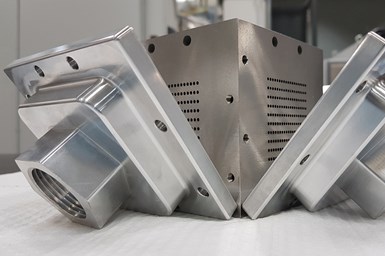Zeiss Evaluates Additive Manufacturing Methods for Oil, Gas Industry
Alliance is researching additive manufacturing of value and critical components of Brazil’s oil and gas industry for onshore and offshore environments.

Compact heat exchanger made from stainless steel AISI 316L printed in SENAI Innovation Institute for Manufacturing Systems and Laser Processing (Joinville-SC) in a project with UFSC and PETROBRAS.
Since January 2021, Zeiss has been working on additive manufacturing (AM) research with the nonprofit, private research and technology organization SENAI (Brazil) and with the energy company Petróleo Brasileiro S.A. (PETROBRAS, Brazil), which specializes in oil and gas. The aim of the research is to develop and validate methodologies for the manufacture and qualification of static as well as dynamic critical components for the oil and gas industry within the next two years.
The research focus is on the evaluation of laser beam powder bed fusion (PBF) as well as laser beam directed energy deposition (DED). These are AM processes that are already used in the production and repair of components such as valves, flanges and heat exchangers. Of particular importance for the economical production of these parts is “a precise understanding of powder aging and the influence of powder degradation on defects in the final parts,” says Dr. Edson Costa Santos, senior application development manager additive manufacturing process and control, Zeiss IQS Germany
By using multiscale, multitool-computed tomography strategies, alliance researchers are applying a scientific and technical approach for rapid parameter development and process stability. As part of the jointly defined roadmap, the research and industrial partners are specifically collaborating on the selection of high added value and critical components of the oil and gas industry for onshore and offshore environments; raw material (powder) processability, recyclability, traceability and quality control; faster development and optimization of processing parameters for laser-based AM of parts by employing a new and robust experimental method; and application of mechanical, wear and nondestructive tests on the additively manufactured parts.
By 2023, the group aims to achieve tangible impacts in the Brazilian AM market through intensive results and technology transfer, and to positively change the supply chain of the oil and gas industry in the medium to long term. As the parts needed in this market are often produced locally and on demand, the companies will then also act more sustainably.
Related Content
-
3D Printed Seal for Geothermal Power: The Cool Parts Show #73
Plugging a hole is a complex challenge when it’s a well for geothermal power. Additive manufacturing produces a shape-changing stainless steel seal for high-temperature applications deep underground.
-
Video: AM for Repair of Large Shafts
Wind power shafts that might once have been scrapped are now returned to service. See the robotic directed energy deposition (DED) and shaft preheating system developed by Ikergune, Izadi and Talens.
-
3D Printed Spacer Grids for Nuclear Power: The Cool Parts Show #79
Westinghouse Electric Company is exploring laser powder bed fusion as a means of manufacturing spacer grids, critical parts of the fuel rod assemblies used in pressurized water reactors.










